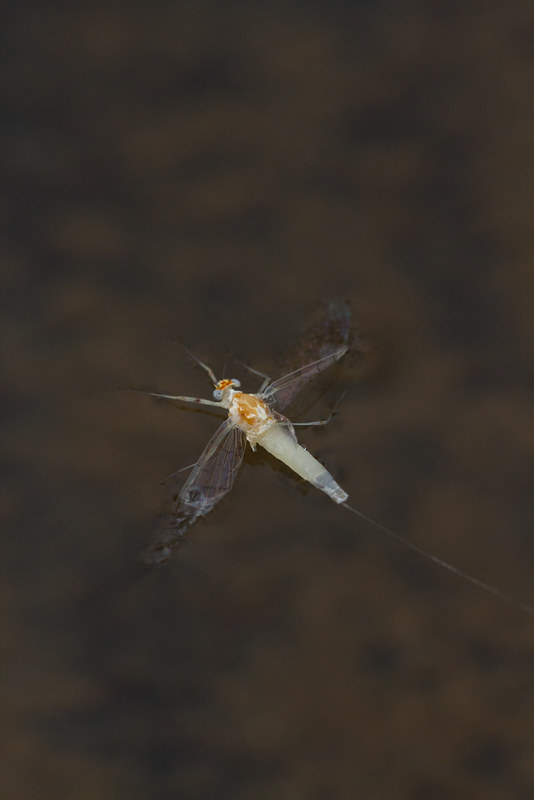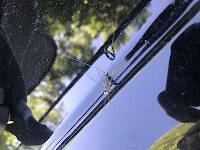
Hex Mayflies
Hexagenia limbata
The famous nocturnal Hex hatch of the Midwest (and a few other lucky locations) stirs to the surface mythically large brown trout that only touch streamers for the rest of the year.
Featured on the forum

Troutnut is a project started in 2003 by salmonid ecologist Jason "Troutnut" Neuswanger to help anglers and
fly tyers unabashedly embrace the entomological side of the sport. Learn more about Troutnut or
support the project for an enhanced experience here.
Taxon on Dec 18, 2014December 18th, 2014, 1:33 pm EST
Gastriper-
Sure, they are both mayflies. However, as this is a world-wide website, where specifically are you located?
Sure, they are both mayflies. However, as this is a world-wide website, where specifically are you located?
Creno on Dec 18, 2014December 18th, 2014, 3:26 pm EST
do not key by geography :-)
Gastriper
Posts: 4
Posts: 4
Gastriper on Dec 18, 2014December 18th, 2014, 3:36 pm EST
Sorry, the bugs are from north Georgia.
Thanks for any help u can give me.
Thanks for any help u can give me.
Taxon on Dec 19, 2014December 19th, 2014, 12:20 am EST
do not key by geography :-)
Hi Dave-
Good one, that :-)
However, expressing taxonomic opinion (concerning a winged mayfly) based on examination of a macro photo is surely not science, although it may come somewhat closer to being an art form. And as such, I believe one need not handicap oneself by ignoring any clue which may contribute to expression of a taxonomic belief, as opposed to an actual id, which has been scientifically derived from microscopic examination of an actual specimen.
Respectfully submitted,
Taxon on Dec 19, 2014December 19th, 2014, 1:16 am EST
Sorry, the bugs are from north Georgia.
Thanks for any help u can give me.
Hi Gastriper-
The mayfly female imago in your first two photos confuses me. Although leaning toward a Heptageniid like genus Maccaffertium based on the light brown cross veins in its forewings, I don't recall ever seeing a Maccaffertium with a wholly unmarked creamy white abdomen, which seems to resemble the abdomen of genus Ephoron. Hmm, perhaps someone who does recognize it can step in, and put me out of my misery.
I believe the female subimago in your third photo to be of genus Isonychia.
Crepuscular on Dec 19, 2014December 19th, 2014, 4:44 am EST
Cool. Nice photos Gastriper! It's been a while since we've seen anything remotely new from the east coast! I agree with you Rodger that the last photo is Isonychia sp.. The first one is a new one for me. First it's legs dont seem to be vestigial so no Polymitarcydae (Ephoron sp.). So going the Heptageniidae route. The Mesonotum looks to have a transverse suture. I wish we had a photo of the ventral thorax...Forewings do not have a black spot joining or nearly joining some crossveins below bullae so that may eliminate Stenacron. the hind tibia look to be shorter than the femora, and the hindwings are well developed. and here is where everything is speculation for me so take it for what it's worth which is not much...Genera that have a unicolorus abdomen in some species that I'm aware of, and I'm sure I'm missing some, are Macdunnoa, Heptagenia, Leucrocuta and maybe Mccafertium but I'm doubtful on that one. So the cross veins don't look dark enough for Leucrocuta to me. I'm leaning toward some Heptagenia sp. butI don't ever recall seeing Macdunnoa so I suppose it could go that way. I don't have access to any keys right now so take my post as just me rambling on about this mayfly...Still a cool bug, thanks again Gastriper.
Eric
EDIT: After doing a little reading, I'd like to hear what others say about Macdunnoa sp.. Reading the description from Flowers 1982, of Macdunnoa brunnea it souds pretty close to what we have here. Gastriper, can you describe the habitat (stream type) where this mayfly could have emerged?
Eric
EDIT: After doing a little reading, I'd like to hear what others say about Macdunnoa sp.. Reading the description from Flowers 1982, of Macdunnoa brunnea it souds pretty close to what we have here. Gastriper, can you describe the habitat (stream type) where this mayfly could have emerged?
Gastriper
Posts: 4
Posts: 4
Gastriper on Dec 19, 2014December 19th, 2014, 7:51 am EST
Could it be a sulfur or pale evening dun?
Taxon on Dec 19, 2014December 19th, 2014, 7:57 am EST
After doing a little reading, I'd like to hear what others say about Macdunnoa sp.
Way to go, Eric. Macdunnoa has never been on my radar (so to speak), as I've never seen either photo or illustration of one in its winged lifestages. However, Macdunnoa persimplex is the only species of Macdunnoa reported to reside in GA, and the abdomen (at least of the male imago) is described in The Biology Of Mayflies as being pale creamy.
Crepuscular on Dec 19, 2014December 19th, 2014, 1:49 pm EST
Way to go, Eric.
Well we'll see. It is definitely a new one for me. Flowers does not have an illustration of the female (or male for that mater) but only a description of the female in alcohol. And he does not mention the markings on the forefemur. If we had a photo of the ventral side of the thorax that would make me feel better about my "identifiguess". An SEM of the egg would be nice too :) So take it for what is is, a unique mayfly,certainly not on my radar either.
Could it be a sulfur or pale evening dun?
Ah the common name dilemma. You can call it whatever you want. If there would be a "correct" common name I suppose that a Cahill would be the one since it generally refers to any one of several species of Heptageniid mayflies. The only other Heptageniid mayfly that is commonly referred to as a sulphur is Epeorus vitreus so I guess you could also argue for the sulphur moniker. Name aside, I'm interested in the fishability of this hatch. Were there enough of these mayflies present to spark some interest from the resident trout? I have absolutely no experience with this bug, and have never heard of anyone who has fished over it. Again Gastriper, nice photos and thanks for posting!
Eric
Timman on Dec 20, 2014December 20th, 2014, 11:13 am EST
Head capsule shape and thorax structure belong to Maccaffertium. Luteum has an orange head and thorax and is commonly unmarked as this sample is.
Fake account made by Brookyman (who was banned for threatening another user)
Crepuscular on Dec 20, 2014December 20th, 2014, 12:12 pm EST
Head capsule shape and thorax structure belong to Maccaffertium. Luteum has an orange head and thorax and is commonly unmarked as this sample is.
Interesting. Can you elaborate on the thorax structure? Like I said I was guessing. The lack of crowding under bullae led me away from Mccaffertium. I realize that is not a character in all Mccaffertium but that and the lack of markings on the abdomen just added to my indecision about this one. :)
Timman on Dec 20, 2014December 20th, 2014, 12:52 pm EST
Maccaffertium luteum is commonly sparsely crowed in the bulla region. The thoracic structural notch is shaped as in Maccaffertium, and the head capsule shape in the frontal shelf also matches that genus. The femora bandings align with this genus, and the general lazy posture is also characteristic for the genus. The abdomen shape and faint to no transverse tergite bandings fits luteum quite well. Luteum also has a very bright orange head on the vertex.
However my suggestion of luteum is basic speculation only.
However my suggestion of luteum is basic speculation only.
Fake account made by Brookyman (who was banned for threatening another user)
Taxon on Dec 20, 2014December 20th, 2014, 1:04 pm EST
Tim-
Although not necessarily exclusionary, I believe recorded distribution for Maccaffertiun luteum would tend to argue against it.
Head capsule shape and thorax structure belong to Maccaffertium. Luteum has an orange head and thorax and is commonly unmarked as this sample is.
Although not necessarily exclusionary, I believe recorded distribution for Maccaffertiun luteum would tend to argue against it.
Crepuscular on Dec 23, 2014December 23rd, 2014, 1:50 am EST
Maccaffertium luteum is commonly sparsely crowed in the bulla region. The thoracic structural notch is shaped as in Maccaffertium, and the head capsule shape in the frontal shelf also matches that genus. The femora bandings align with this genus, and the general lazy posture is also characteristic for the genus. The abdomen shape and faint to no transverse tergite bandings fits luteum quite well. Luteum also has a very bright orange head on the vertex.
However my suggestion of luteum is basic speculation only.
Hey Tim, thanks for your input on this mayfly! Those marks on the forefemora had me wondering too. Do you happen to have any photos of Mccaffertium luteum feamale imagos (or males for that matter)? It would be interesting to me to see one as that's another Heptageniid that I am not familiar with other than in name.
Eric
Timman on Dec 23, 2014December 23rd, 2014, 4:01 pm EST
Jeff would know better than anyone. I think this is a luteum as well at least 95% sure. There is a picture of a male floating around on the bug guide that was never marked as species. Range does play a roll in species but many samples are not reported properly by people in the field. I know many biologist that can only barely say for sure that.
That's a vicarium or modestum !!
It could be many species luteum is just a logical guess by me.

That's a vicarium or modestum !!
It could be many species luteum is just a logical guess by me.

Fake account made by Brookyman (who was banned for threatening another user)
Timman on Dec 24, 2014December 24th, 2014, 11:14 am EST
After some reading and although luteum is possible there are others that are even more likely. Based on Traver 33 + 35, Burks 1953, Lewis 1974 and finally Bednarik & McCafferty 1979 I now believe the following;
These pictured samples appear to align with two forms in particular that were at one time species. So that said, these samples more align with the Maccaffertium terminatum complex as synonym forms. There are two forms that align in this complex and one is the more likely. lepton and bipunctatum are the two most likely and from what I am reading I now believe that this is (Maccaffertium terminatum/lepton).
These pictured samples appear to align with two forms in particular that were at one time species. So that said, these samples more align with the Maccaffertium terminatum complex as synonym forms. There are two forms that align in this complex and one is the more likely. lepton and bipunctatum are the two most likely and from what I am reading I now believe that this is (Maccaffertium terminatum/lepton).
Fake account made by Brookyman (who was banned for threatening another user)
Entoman on Jan 10, 2015January 10th, 2015, 12:53 pm EST
Welcome Gastriper!
Female heptageniids are very difficult to nail down without an associated male. I've been burnt so many times trying to extrapolate diagnostic characters from papers and keys that are male based... For the majority of photos we are throwing darts blind unless they are highly detailed in the right spots or a worker familiar with the species (and location) happens to see them and chimes in. Anyway that's my excuse for not offering an opinion even as to which genus it's in, let alone species. :)
Roger -
Doesn't this one look eerily reminiscent of several southern heptageniids we've been scratching our heads over - and for some time?
Female heptageniids are very difficult to nail down without an associated male. I've been burnt so many times trying to extrapolate diagnostic characters from papers and keys that are male based... For the majority of photos we are throwing darts blind unless they are highly detailed in the right spots or a worker familiar with the species (and location) happens to see them and chimes in. Anyway that's my excuse for not offering an opinion even as to which genus it's in, let alone species. :)
Roger -
Doesn't this one look eerily reminiscent of several southern heptageniids we've been scratching our heads over - and for some time?
"It's not that I find fishing so important, it's just that I find all other endeavors of Man equally unimportant... And not nearly as much fun!" Robert Traver, Anatomy of a Fisherman
Timman on Jan 12, 2015January 12th, 2015, 12:34 pm EST
Darts is a great game.
Fake account made by Brookyman (who was banned for threatening another user)
Quick Reply
Related Discussions
Topic
Replies
Last Reply
1
Oct 24, 2006
by Troutnut
by Troutnut
2
Feb 6, 2017
by Crepuscular
by Crepuscular
4
May 24, 2008
by Softhackle
by Softhackle
1
Sep 9, 2008
by GONZO
by GONZO
6
Nov 12, 2006
by Martinlf
by Martinlf












